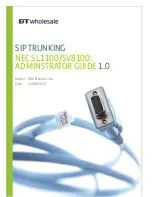
Conditions
CAUTION
There is a risk that fraudulent telephone calls will be made if a third party discovers a personal identification
number (PIN) (verification code PIN or extension PIN) of the PBX. The cost of such calls will be billed to
the owner/renter of the PBX. To protect the PBX from this kind of fraudulent use, we strongly recommend:
a.
Keeping PINs secret.
b.
Selecting complex, random PINs that cannot be easily guessed.
c.
Changing PINs regularly.
•
Extension PIN Lock
If the extension PIN is entered incorrectly three times, the line will be disconnected. If an incorrect PIN is
entered a preprogrammed number of times, the PIN will be locked. Only an extension assigned as a
manager can unlock a PIN, after which it will be reset. In this case, the PIN will be unlocked and cleared.
This feature is also known as Station Password Lock.
•
Remote Extension PIN Clear
If an extension user forgets his or her PIN, a manager can clear (reset) the PIN, and the extension user
can assign a new PIN.
•
Extension PIN Display
It is possible to select whether to show the extension PIN on the display through system programming. By
default, it is shown as dots.
PC Programming Manual References
4.5 [2-3] Timers & Counters—Miscellaneous—
Extension PIN—Lock Counter
4.9 [2-6-1] Numbering Plan—Main—Features—
Extension PIN Set / Cancel
4.18 [2-9] System Options—Option 1—
PT LCD—Password / PIN Display
6.1 [4-1-1] Wired Extension—Extension Settings—Main—
Extension PIN
6.10 [4-2-1] Portable Station—Extension Settings—Main—
Extension PIN
PT Programming Manual References
[005] Extension Personal Identification Number (PIN)
Operating Manual References
3.1.2 Personal Programming
3.2.2 Manager Programmingf
5.1.7 Extension Port Configuration
Description
There are three types of extension ports, used to connect digital proprietary telephones (DPTs), analog
proprietary telephones (APTs), single line telephones (SLTs), Cell Stations (CSs), DSS Consoles, and Voice
Processing Systems (VPS) to the PBX. The devices which can be connected to each type of port are listed
below.
a.
DPT Port:
DPT, DSS Console, Panasonic VPS which supports DPT (Digital) Integration, and PT-interface
CS (e.g., KX-TDA0141)
b.
SLT Port:
SLT and Panasonic VPS which supports DTMF Integration
c.
Super Hybrid Port:
DPT, APT, SLT, DSS Console, Panasonic VPS, and PT-interface CS
Document Version 2009-12
Feature Manual
95
5.1.7 Extension Port Configuration
Summary of Contents for KX-NCP500
Page 12: ...12 Feature Manual Document Version 2009 12 Table of Contents...
Page 13: ...Section 1 Features and Configurations A Document Version 2009 12 Feature Manual 13...
Page 26: ...26 Feature Manual Document Version 2009 12 1 1 7 Automatic Time Adjustment...
Page 27: ...Section 2 Features and Configurations B Document Version 2009 12 Feature Manual 27...
Page 29: ...Section 3 Features and Configurations C Document Version 2009 12 Feature Manual 29...
Page 64: ...64 Feature Manual Document Version 2009 12 3 1 23 CTI Computer Telephony Integration...
Page 65: ...Section 4 Features and Configurations D Document Version 2009 12 Feature Manual 65...
Page 89: ...Section 5 Features and Configurations E Document Version 2009 12 Feature Manual 89...
Page 100: ...100 Feature Manual Document Version 2009 12 5 1 9 External Sensor...
Page 101: ...Section 6 Features and Configurations F Document Version 2009 12 Feature Manual 101...
Page 121: ...Section 7 Features and Configurations G Document Version 2009 12 Feature Manual 121...
Page 126: ...126 Feature Manual Document Version 2009 12 7 1 1 GROUP FEATURES...
Page 127: ...Section 8 Features and Configurations H Document Version 2009 12 Feature Manual 127...
Page 134: ...134 Feature Manual Document Version 2009 12 8 1 6 Hot Line...
Page 135: ...Section 9 Features and Configurations I Document Version 2009 12 Feature Manual 135...
Page 169: ...Section 10 Features and Configurations L Document Version 2009 12 Feature Manual 169...
Page 177: ...Section 11 Features and Configurations M Document Version 2009 12 Feature Manual 177...
Page 186: ...186 Feature Manual Document Version 2009 12 11 1 5 Mute...
Page 187: ...Section 12 Features and Configurations O Document Version 2009 12 Feature Manual 187...
Page 194: ...194 Feature Manual Document Version 2009 12 12 1 5 Operator Features...
Page 195: ...Section 13 Features and Configurations P Document Version 2009 12 Feature Manual 195...
Page 268: ...268 Feature Manual Document Version 2009 12 13 1 30 PT Programming...
Page 269: ...Section 14 Features and Configurations Q Document Version 2009 12 Feature Manual 269...
Page 272: ...272 Feature Manual Document Version 2009 12 14 1 2 Quick Setup...
Page 273: ...Section 15 Features and Configurations R Document Version 2009 12 Feature Manual 273...
Page 279: ...Section 16 Features and Configurations S Document Version 2009 12 Feature Manual 279...
Page 301: ...Section 17 Features and Configurations T Document Version 2009 12 Feature Manual 301...
Page 321: ...Section 18 Features and Configurations U Document Version 2009 12 Feature Manual 321...
Page 323: ...Section 19 Features and Configurations V Document Version 2009 12 Feature Manual 323...
Page 344: ...344 Feature Manual Document Version 2009 12 19 1 5 Voice Mail DTMF Integration...
Page 345: ...Section 20 Features and Configurations W Document Version 2009 12 Feature Manual 345...
Page 354: ...354 Feature Manual Document Version 2009 12 20 1 5 Wireless XDP Parallel Mode...
Page 355: ...Section 21 Appendix Document Version 2009 12 Feature Manual 355...
Page 369: ...Index Document Version 2009 12 Feature Manual 369...
Page 375: ...Document Version 2009 12 Feature Manual 375 Notes...




































